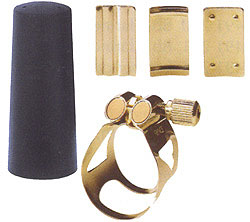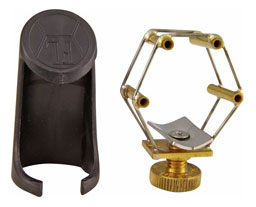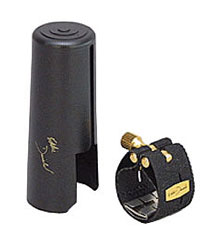A Comparison of 3 Popular Saxophone Ligatures
Ligatures- do they make a difference? I have heard and read many reviews about the saxophone ligature and whether or not it had an effect on one’s sound. From my personal experience, I think a ligature has two goals.
The first goal is to simply hold the reed on the mouthpiece, and the second goal is to make the reed vibrate in a way that allows you to best express yourself. I will be reviewing three ligatures that I believe make a difference in a player’s sound while allowing the player to get that little something extra they have been looking for in their sound.
Vandoren Optimum ligature
 When I bought my V16 t45 metal mouthpiece, I purchased the Vandoren Optimum ligature because it seemed to hold the reed on tight and I wanted to see how the three different pressure plates would affect my sound. Each pressure plate can make your sound a little bit brighter, darker, or a little bit edgier depending on how much air you push through the mouthpiece.
When I bought my V16 t45 metal mouthpiece, I purchased the Vandoren Optimum ligature because it seemed to hold the reed on tight and I wanted to see how the three different pressure plates would affect my sound. Each pressure plate can make your sound a little bit brighter, darker, or a little bit edgier depending on how much air you push through the mouthpiece.
I found the Vandoren Optimum ligature to fit comfortably around my V16 mouthpiece and I saw no issues of the ligature bending from trying to fasten it on. Overall the V16 ligature keeps the reed where it needs to be and is very easy to adjust. I would recommend it to all saxophone players playing in any style. The ligature is priced between $60-$70 dollars with many different packages depending on whether you just buy the ligature with one pressure plate or the ligature without the cap.
Francois Louis Ultimate ligature
 This ligature is very similar to the Vandoren Optimum in terms of the different sounds you can get, but instead of the varying sounds based on pressure plates, it’s the material which changes the sound. The ligature comes in three different materials: brass, silver, and gold.
This ligature is very similar to the Vandoren Optimum in terms of the different sounds you can get, but instead of the varying sounds based on pressure plates, it’s the material which changes the sound. The ligature comes in three different materials: brass, silver, and gold.
According to Francois Louis, the brass ligature is supposed to open up your sound and resonate the most, the silver ligature offers a bit more resistance and will give you a darker sound, and finally the gold ligature is possesses a more polished and elegant sound. After trying the gold, silver, and brass ligature on my Otto Link hard rubber, I felt that the standard brass ligature was the best fit for me because it opened up my sound and allowed me to play with a brighter or darker tone. The Francois Louis ligature fits great on a metal Otto Link and V16 alto or tenor mouthpiece. I would recommend trying out the three different finishes to see which one fits you the best.
One small complaint is if the mouthpiece is on the larger end of the spectrum, the ligature is hard to adjust and could move when trying to do so. The Francois Louis ligature starts between $60 and increases based on the type of material you want (the silver and gold are both more expensive than the standard brass ligature.)
Eddie Daniels Rovner ligature (now known as Rovner Versa)
 I recently bought the Eddie Daniels ligature for my Meyer 6 on alto saxophone because I wanted something that would open up my sound and allow me to produce a bright and edgy tone. Since I purchased this ligature, the model name has been changed to “Rovner Versa.” At any rate, I know many students use the standard Rovner ligature for classical or jazz playing, but the pressure plate that sits blow the reed on this ligature allows the reed to vibrate in a way that allows my sound to really cut through in a saxophone section.
I recently bought the Eddie Daniels ligature for my Meyer 6 on alto saxophone because I wanted something that would open up my sound and allow me to produce a bright and edgy tone. Since I purchased this ligature, the model name has been changed to “Rovner Versa.” At any rate, I know many students use the standard Rovner ligature for classical or jazz playing, but the pressure plate that sits blow the reed on this ligature allows the reed to vibrate in a way that allows my sound to really cut through in a saxophone section.
This ligature is made out of the same black leather that goes into the standard Rovner ligature. The metal pressure plate can be switched out with other plates depending on what type of sound you are going after, but I would recommend the plate that comes with the ligature because it seemed to work best for me.
The Eddie Daniels/Versa ligature runs around $40+ dollars and comes with a black cap (with Eddie Daniels’ signature in my case). In comparison to other ligatures I have found this one to give me the brighter and edgier sound that helps me sound in the vein of modern straight-ahead alto players such as Antonio Hart or Vincent Herring.
Conclusion
There has been much discussion as to whether a ligature has a major effect on your sound. After trying the Vandoren Optimum ligature, the Francois Louis ligature, and the Eddie Daniels Rovner ligature, I would say that the ligature can give the player a bit more freedom in terms of arriving at one’s desired tonal characteristics. I would recommend trying as many different types of ligatures as possible to see which one fits you best. All three of these ligatures are great because they are well built and can offer the saxophonist a wide variety of sounds.






December 27, 2011 @ 11:58 am
nice article.
I for myself have littel “ligature fetish”
http://saxophonistisches.de/der-grose-blattschraubenreport/
Your know, that Francois Louis has also a Pure Brass Ligature. It’s a bit different, more massiv and gives the tone more deep frequenzes and is more resonant.
Furthermore there are different pressure plates for the FL. The normal, one with a rubber inlay and a heavy brass plate. The difference in sound is very notable.
December 27, 2011 @ 1:24 pm
I have heard of his new ligature, and do agree with you how changing the pressure plates can make a difference. I have tried the newest version of the Francois Louis ligature, and really liked it, but found it to be a bit expensive. None the less, it is a great ligature.
June 23, 2012 @ 8:06 pm
You know I haven’t tried the Vandorean lig reviewed here. But I tried tried the Eddie Daniel’s/Rovner and the Francois Louis ligs. The FL lig made the reed to soft on my tenor, a Mk VI. I just didn’t like it, the sound was what I call loosey-goosey. Kind of like runny eggs instead of firm eggs. The ED/Rovner just seems to spread with not enough core and bite to the sound. I do however like the ED/Rovner on clarinet.
On my tenor sax w/a metal FL Link 60’s vintage 8* I like the old standby, the Silver Selmer standard lig for metal mpcs. On alto with a Meyer USA mpc made in Elkhart I like the standard brass gauge Selmer lig.
I know Phil Rovner, real nice guy, I like him. He lived near me in a Baltimore suburb. At 1 time we played in the same rehearsal band. We even played sax duets for a while together. All that being said, I can play his ligs but I prefer the Selmer ligs. I came to this conclusion by listening to recordings of myself playing the different setups.
However give them a try for yourself and see what works for you.
June 23, 2012 @ 8:12 pm
Btw – one of my teachers told me he felt this way about ligs. He said a lig is just something to hold your reed on. Fyi – he played a standard brass gauge Selmer lig on his Meyer alto mpc w/a LaVoz reed. Before you write to criticse him this guy is a Great Phil Woods type of alto player. I won’t name him here except to say he plays/teaches in DC and he plays Great!!
September 2, 2012 @ 9:51 pm
Thanks for the review Zach.
It would be really helpful to hear some samples.
September 29, 2012 @ 4:04 pm
I have the Rovner Versa and I love it!!
January 24, 2013 @ 3:10 pm
Hi Zach!
I have a Vandoren v16 Metal Tenor mouthpiece. The Rovner Versa fits well on it ?
Thanks for the review,
Diego from Argentina
Putting Rovner Ligatures to the Test and Picking Winners | Best. Saxophone. Website. Ever.
June 20, 2013 @ 6:02 am
[…] I have always seen many musicians using Rovner ligatures on both saxophone and clarinet. In one of my first reviews, I reviewed a group of ligatures which included the Rovner Eddie Daniels Edition ligature (which I […]
November 25, 2013 @ 8:20 am
custom and Handmade, one ligature fit and work on different sax and metal and rubber mouthpieces.